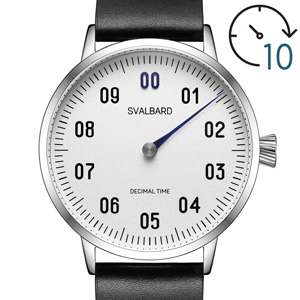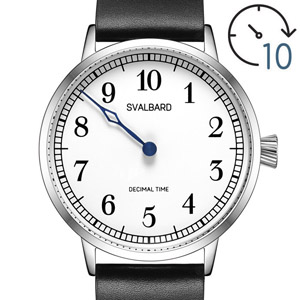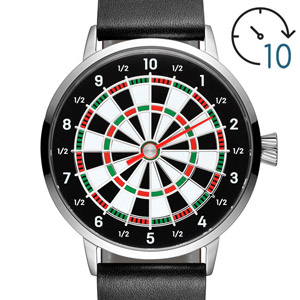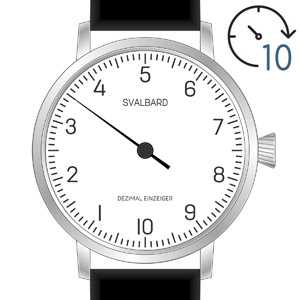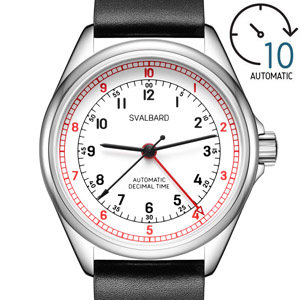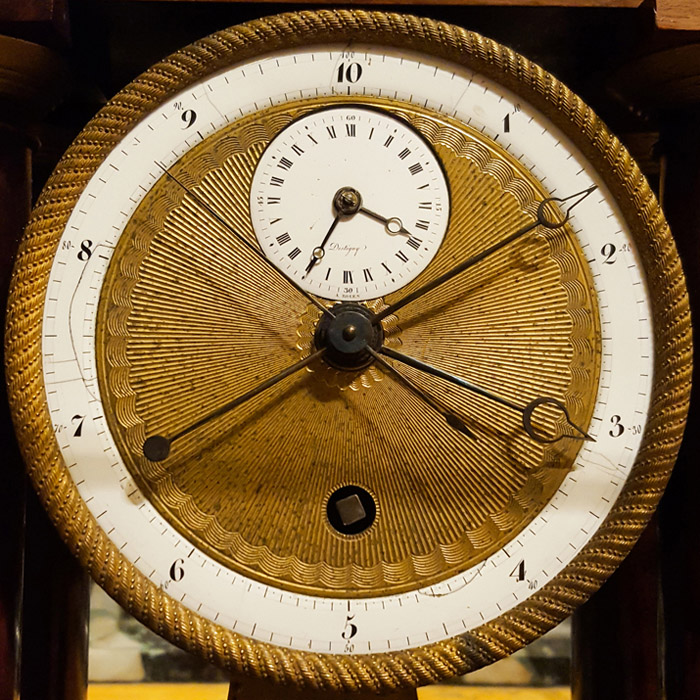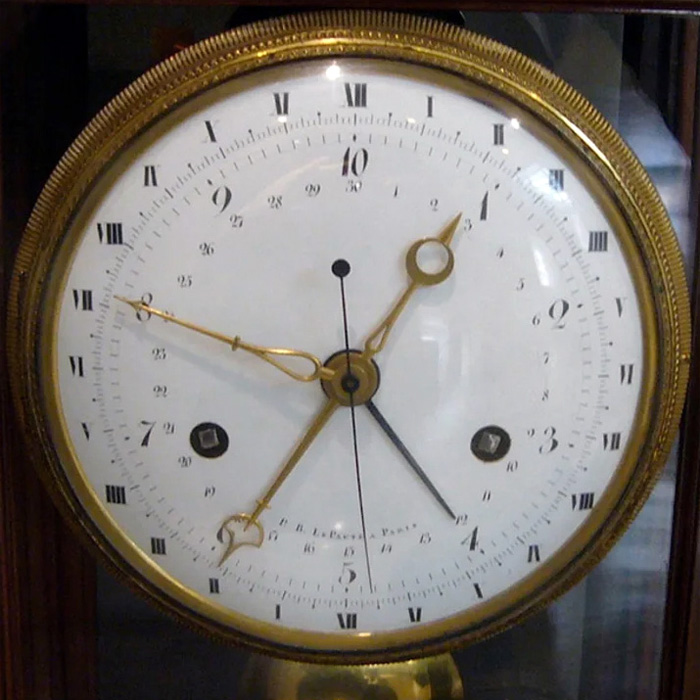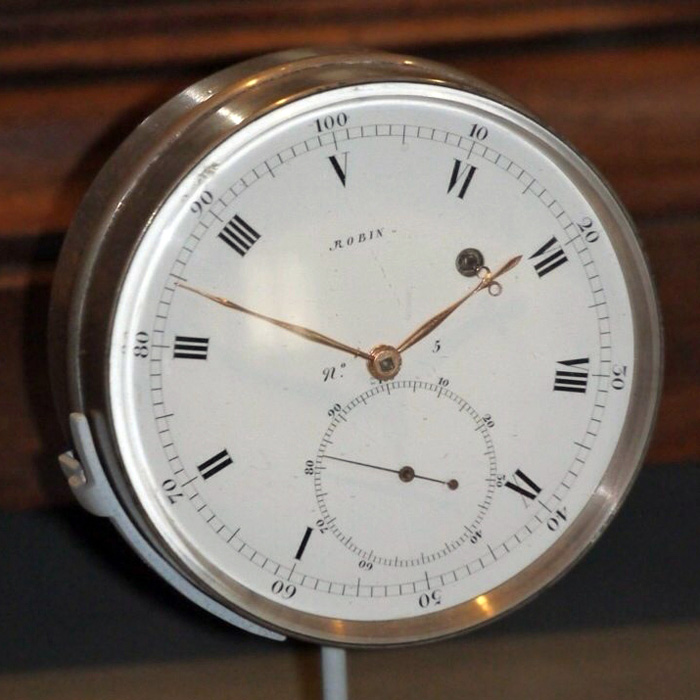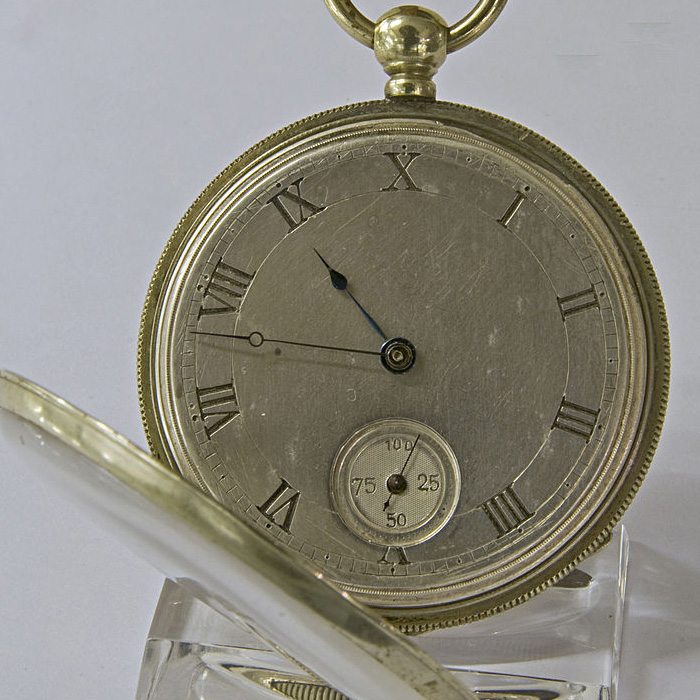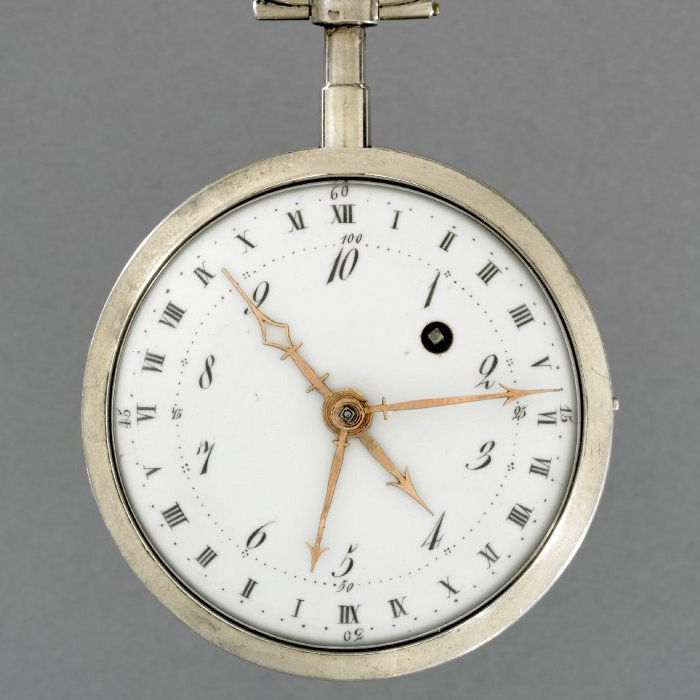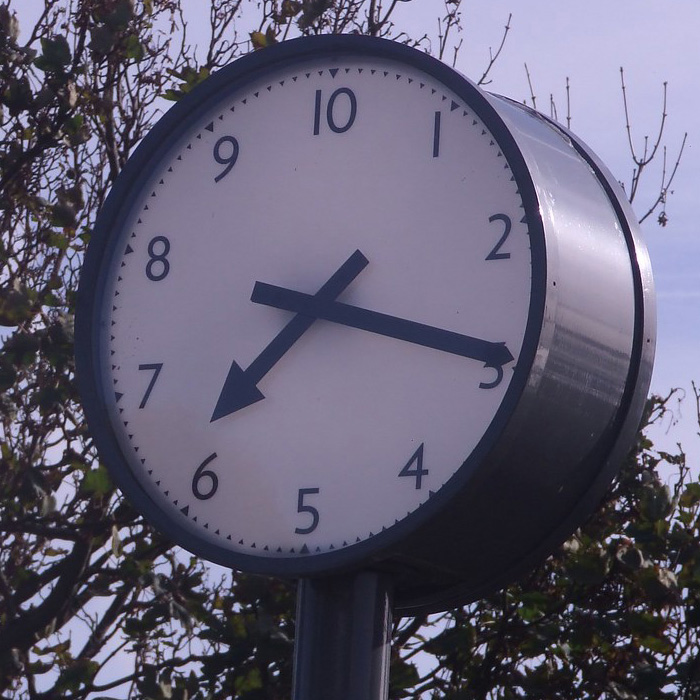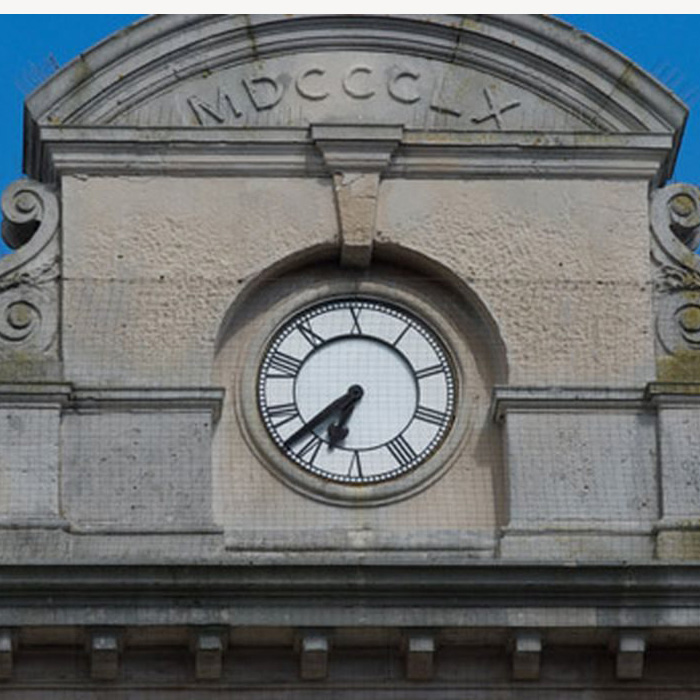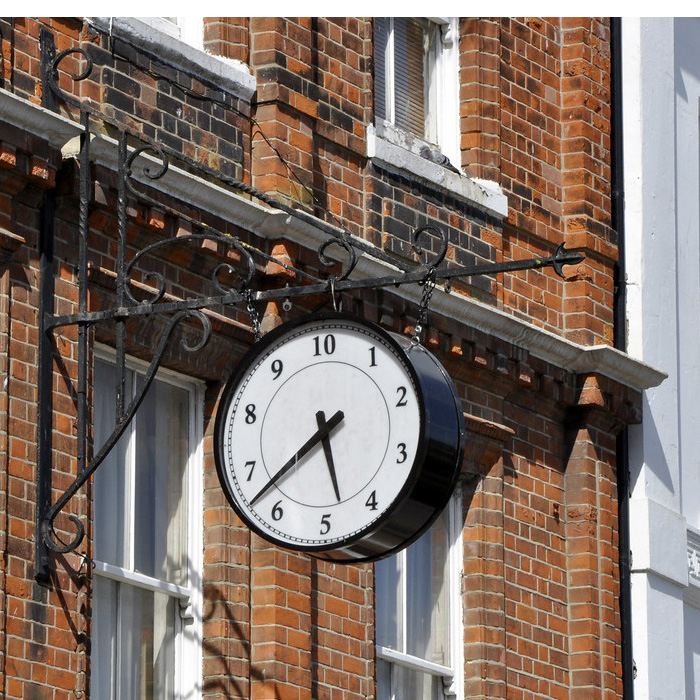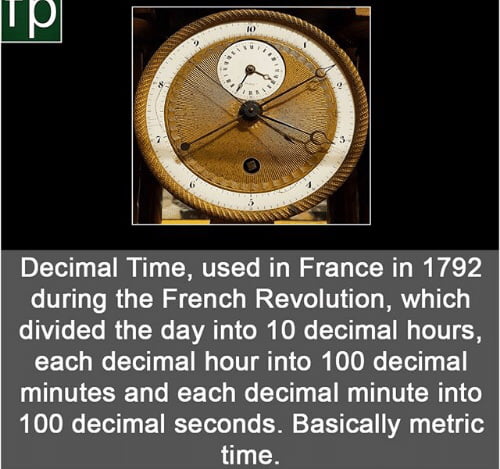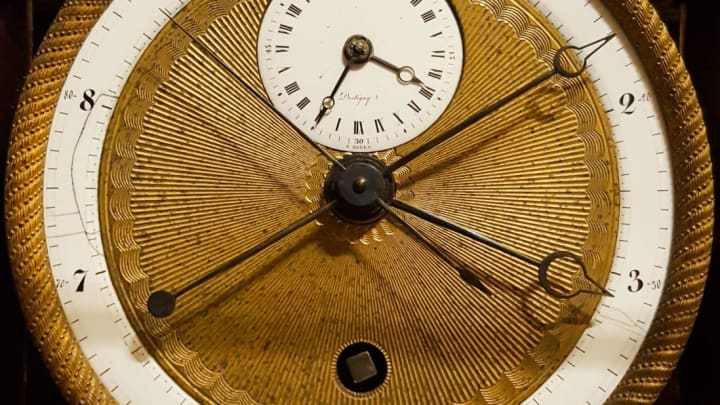|
|
FRENCH REVOLUTIONARY (DECIMAL) TIME
Everybody knows that there are 24 hours in a day, 60 minutes in an hour, and 60 seconds in minute. But in 1793, the French smashed the old clock system in favor of French Revolutionary Time, which was a 10-hour day, with 100 minutes per hour, and 100 seconds per minute. This thoroughly modern system had a few practical benefits, chief among them being a simplified way to do time-related math. If we want to know when a day is 80% complete, decimal time simply says "at the end of the eighth hour," whereas standard time requires us to say "at 19 hours, 12 minutes." French Revolutionary Time was a more elegant solution to that math problem. The problem was that every living person already had a well-established way of telling the time, and old habits die hard!
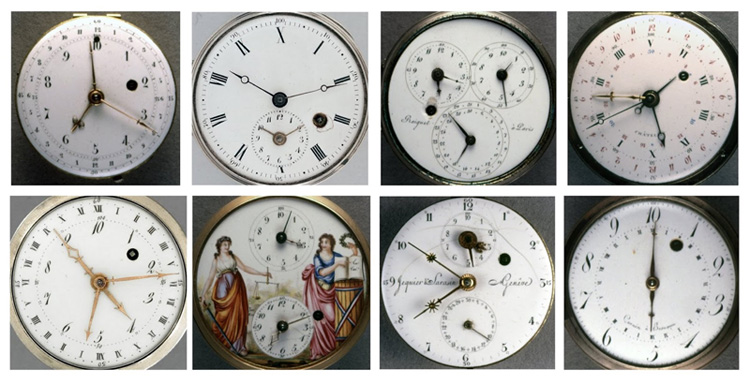 French Revolutionary Time officially began on November 24, 1793 although conceptual work around the system had been going on since the 1750s. The French manufactured clocks and watches showing both decimal time and standard time on their faces (allowing for both conversion and confusion). These clock faces were spectacularly weird. French Revolutionary Time officially began on November 24, 1793 although conceptual work around the system had been going on since the 1750s. The French manufactured clocks and watches showing both decimal time and standard time on their faces (allowing for both conversion and confusion). These clock faces were spectacularly weird.
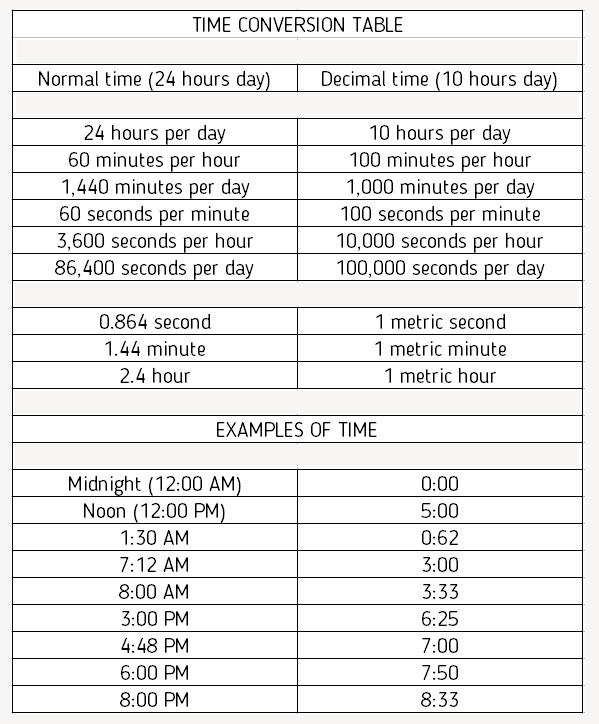
The system proved unpopular. People were unfamiliar with switching systems of time, and there were few practical reasons for non-mathematicians to change how they told time. (The same could not be said of the metric system of weights and measurements, which helped to standardize commerce; weights and measurements often differed in neighboring countries, but clocks generally did not.) Furthermore, replacing every clock and watch in the country was an expensive proposition. The French officially stopped using decimal time after just 17 months. French Revolutionary Time became non-mandatory starting on April 7, 1795. This didn't stop some areas of the country from continuing to observe decimal time, and a few decimal clocks remained in use for years afterwards, presumably leading to many missed appointments!
LIVE NORMAL AND DECIMAL TIME
Live NORMAL time
Live DECIMAL time
DECIMAL TO NORMAL / NORMAL TO DECIMAL TIME CONVERTER
Some applications using decimal time are available in both Google Play and the Apple Store. For example, for Android - DecimalTime ; for Apple - DeciTime .
LOOK/PURCHASE SVALBARD DECIMAL TIME WATCHES
IMAGES OF DECIMAL CLOCKS AND WATCHES
https://svalbard.watch/pages/about_decimal_time.html |
|
|
|
|
The new metric time wouldn’t fitting in with the rotation of the planet. rendered this idea impractical, at best.
100 (secs) x 100 (mins) x 10 (hrs) would have made a metric day 100,000 seconds.
Our normal day based on the rotation of the planet is:
60 (secs) x 60 (mins) x 24 (hrs) making a standard day 86,400 seconds.
So a metric day would have been 13,600 seconds, or 3.77 standard hours longer (assuming a second was the same length of time in both systems of measurement).
After 3 metric days we would have been 11.33 standard hours out of sync with a natural day. At midnight the sun would have been high in the sky.
Answered: In 1792, France experimented with decimal time, making a day 10 hours, an hour 100 minutes, and a minute 100 seconds. Why did this new standard for timekeeping not take off when so much of the world uses a base 10 system for measuring stuff?
https://www.quora.com/In-1793-decimal-time-was-tried-in-the-French-Revolution-10-hr-day-x-100-min-hr-x-100-sec-min-instead-of-24-x-60-x-60-Why-was-decimal-time-unsuccessful-after-1795 |
|
|
|
|
I don’t know if it’s a right answer but I think it’s because the numerical system used was/is decimal
Known in the west as arabic number (0, 1, 2, 3, 4, 5, 6, 7, 8, 9) but originated from India it’s a decimal system (ten symbols)
and the vast majority of human numerical system is decimal.
I guess that’s why.
But yes the base 12 system would have been interesting (not only for measurment but priorly for mathematics)
divider in decimal system 2 and 5
divider in 12 system 3, 2 and 2 again
https://www.quora.com/In-1793-decimal-time-was-tried-in-the-French-Revolution-10-hr-day-x-100-min-hr-x-100-sec-min-instead-of-24-x-60-x-60-Why-was-decimal-time-unsuccessful-after-1795 |
|
|
|
|
Decimal Time: How the French Made a 10-Hour Day
Everybody knows that there are 24 hours in a day, 60 minutes in an hour, and 60 seconds in minute.* But in 1793, the French smashed the old clock in favor of French Revolutionary Time: a 10-hour day, with 100 minutes per hour, and 100 seconds per minute. This thoroughly modern system had a few practical benefits, chief among them being a simplified way to do time-related math: if we want to know when a day is 70 percent complete, decimal time simply says "at the end of the seventh hour," whereas standard time requires us to say "at 16 hours, 48 minutes." French Revolutionary Time was a more elegant solution to that math problem. The trick was that every living person already had a well-established way to tell time, and old habits die hard.
Noon is at Five in Decimal Time
French Revolutionary Time officially began on November 24, 1793, although conceptual work around the system had been going on since the 1750s. The French manufactured clocks and watches showing both decimal time and standard time on their faces (allowing for conversion and confusion).
The system proved unpopular. People were unfamiliar with switching systems of time, and there were few practical reasons for non-mathematicians to change how they told time. (The same could not be said of the metric system of weights and measurements, which helped to standardize commerce; weights and measurements often differed in neighboring countries, but clocks generally did not.) Furthermore, replacing every clock and watch in the country was a spendy proposition. The French officially stopped using decimal time after just 17 months: French Revolutionary Time became non-mandatory starting on April 7, 1795. This didn't stop some areas of the country from continuing to observe decimal time, and a few decimal clocks remained in use for years afterwards, presumably leading to many missed appointments.
Other Attempts at Decimal Time
The French Republican Calendar was another attempt by revolutionary France to decimalize everything. It wasn't particularly successful.
The French tried again in 1897, when the Commission de Décimalisation du Temps proposed a 24-hour day with 100-minute hours, again with 100 seconds per minute. This proposal was scrapped in 1900.
And then, of course, there's the Stardate, a pseudo-decimal system of date measurement used in Star Trek. Unsurprisingly, the Stardate started out being supremely imprecise and was just supposed to sound futuristic; here's a snippet from the Star Trek Guide for teleplay writers on the original series:
"Pick any combination of four numbers plus a percentage point, use it as your story's stardate. For example, 1313.5 is twelve o'clock noon of one day and 1314.5 would be noon of the next day. Each percentage point is roughly equivalent to one-tenth of one day."
And lest we forget Swiss watchmakers in all of this, Swatch introduced their own bizarre decimal time system in 1998. Called Swatch Internet Time, it divided the day into ".beats" (yes, with a dot) and referred to a particular .beat using the @ symbol (so you might say, "ICQ me at @484 so we can swap some beenz, LOL!"). Each .beat lasted 1 minute and 26.4 seconds and represented 1/1000 of a day. Nope, not confusing @all.
* = There are actually several exceptions to the 24/60/60 rule, most notably leap seconds, but let's keep it simple.
A version of this story ran in 2013; it has been updated for 2021.
https://www.mentalfloss.com/article/32127/decimal-time-how-french-made-10-hour-day |
|
|
|
|
France had a calendar with 10-hour days during the revolution.
French Revolutionary Time was a short-lived concept that used a base-10 timekeeping system. Otherwise known as “decimal time,” this unprecedented method included 10-hour days, 100 minutes per hour, and 100 seconds per minute. Each day was divided into 10 equal parts, with “zero” marking the start (what is now midnight) and “five” denoting the midpoint (noon). This meant that every hour was more than twice as long as an hour of standard time. New clocks and watches were even manufactured displaying both decimal time and standard time, to considerable confusion.
While France formally adopted this practice on November 24, 1793, the idea was first promoted in 1754. That year, mathematician Jean le Rond d’Alembert drew inspiration from the base-10 numeral system that had existed since ancient times and argued that it would be easier and more convenient to calculate times that were divisible by 10. The concept was revived in 1788 and met with enthusiasm from French revolutionaries seeking to shed their ties to the past. French Revolutionary Time was later adopted by the French Parliament, though it proved to be unpopular among citizens who found the switch confusing. The new system was deemed optional on April 7, 1795, and the country ultimately reverted to the previous timekeeping method.
In addition to changing how the country kept time, revolutionary France also adopted the French Republican calendar. The new formula divided the year into 12 months, each of which contained three 10-day weeks. To bring the total days up to 365, France tacked on five additional days at the end of the year as holidays. Debuted on October 24, 1793, the new calendar was also short-lived, and was abolished by Napoleon Bonaparte on January 1, 1806.
You may also like
By the Numbers
DID YOU KNOW?
September 1752 was only 19 days long in Britain.
In 1752, the month of September was only 19 days long throughout the British Empire (including its colonies in America), due to the Calendar (New Style) Act of 1750. That parliamentary move transferred the British from the Julian calendar to the Gregorian calendar, the former having overestimated each year's length by about 11 minutes. Back in 1582, Pope Gregory XIII had declared that all countries under the dominion of the Catholic Church needed to adopt the Gregorian calendar, but many Protestant nations — including England — resisted those demands. When Britain finally converted to the Gregorian calendar in 1752 in an effort to catch up with other nations, the country jumped straight from September 2 to September 14, skipping the 11 days in between to account for the errors of the old calendar.
https://historyfacts.com/world-history/fact/france-had-a-calendar-with-10-hour-days-during-the-revolution/ |
|
|
|
|
Tiempo decimal
Se denomina tiempo decimal a la expresión de la extensión del día utilizando unidades que se encuentran relacionadas mediante un sistema decimal. Este término es utilizado para referirse específicamente al tiempo revolucionario francés, el cual divide al día en 10 horas decimales, cada hora decimal en 100 minutos decimales y cada minuto decimal en 100 segundos decimales, en contraposición al tiempo estándar usual, en el cual el día se divide en 24 horas, cada hora en 60 minutos y cada minuto en 60 segundos.
 Reloj decimal francés de la época de la Revolución francesa.
El tiempo decimal fue utilizado en China a lo largo de casi toda su historia junto con el tiempo duodecimal. Hacia el año 1000 a. C. el día que se extendía desde una medianoche a la medianoche siguiente se encontraba dividido en 12 horas dobles (chino tradicional: 時辰; chino simplificado: 时辰; pinyin: shíchen) y 100 ke (Hanzi: 刻; Pinyin: kè).[1] Durante tres períodos breves se utilizaron un número diferente de kes por día, 120 ke durante 5–3 A.d. C., 96 ke durante 507–544, y 108 ke durante 544–565. Varios de los casi 50 calendarios chinos también dividieron cada ke en 100 fen, aunque en otros cada ke era dividido en 60 fen. En 1280, el calendario Shoushi (Season Granting) subdividió a cada fen en 100 miao, creando un sistema decimal completo de 100 ke, 100 fen y 100 miao.[2] El tiempo decimal chino dejó de ser utilizado en 1645 cuando el calendario Shixian (Constant Conformity), basado en la astronomía europea llevada a China por los jesuitas, adoptó 96 ke por día junto con 12 horas dobles, con lo cual cada ke corresponde exactamente a un cuarto de hora.[3]
En tiempos modernos, el tiempo decimal fue introducido durante la Revolución francesa por un decreto promulgado el 5 de octubre de 1793:
- XI. Le jour, de minuit à minuit, est divisé en dix parties, chaque partie en dix autres, ainsi de suite jusqu’à la plus petite portion commensurable de la durée.
- XI. El día, desde medianoche hasta la medianoche siguiente, se divide en diez partes, cada parte a su vez se compone de diez partes, y así sucesivamente hasta la duración de tiempo más pequeña que se pueda medir.
Se les dio nombre a estas partes el 24 de noviembre de 1793 (4 Frimario del Año II). Las divisiones primarias se denominaron horas, y se agregó:
- La centième partie de l'heure est appelée minute décimale; la centième partie de la minute est appelée seconde décimale. (énfasis en el original)
- La centésima parte de una hora es denominada minuto decimal; la centésima parte de un minuto es denominada segundo decimal.
Por lo tanto, medianoche correspondía a la hora 10, mediodía a la hora 5, etc. Si bien se fabricaron relojes con cuadrantes mostrando el tiempo estándar con los números 1–24 y el tiempo decimal con los números 1–10, el tiempo decimal nunca contó con gran aceptación; no fue utilizado de manera oficial hasta comienzos del año Republicano III, 22 de septiembre de 1794, y el uso obligatorio fue suspendido el 7 de abril de 1795 (18 Germinal del Año III), mediante la misma ley que introdujo el sistema métrico original. Por lo tanto, inicialmente el sistema métrico no poseía una unidad de tiempo, y versiones posteriores del sistema métrico utilizan el segundo, igual a 1/86400 de día, como unidad de tiempo métrico.
El tiempo decimal fue introducido como parte del calendario republicano francés, en el cual además de dividir el día en forma decimal, dividió al mes en tres décadas de 10 días cada una; este calendario fue abolido a finales del 1805. El comienzo de cada año era determinado según el día en él tenía lugar el equinoccio de otoño, en relación con el tiempo solar aparente o verdadero en el Observatorio de París. El tiempo decimal habría sido expresado también según el tiempo solar aparente, dependiendo de la posición desde la cual se lo registraba, como ya era la costumbre general para ajustar los relojes.
En 1897 los franceses realizaron otro intento de decimalizar el tiempo, cuando se creó la Commission de décimalisation du temps en el Bureau des Longitudes, siendo secretario el matemático Henri Poincaré. La comisión propuso un compromiso, al mantener el día de 24 horas, pero dividir cada hora en 100 minutos decimales, y cada minuto en 100 segundos. El plan no tuvo buena acogida y fue abandonado en 1900.
Hay exactamente 86.400 segundos estándar (véase SI para una definición actual del segundo estándar) en un día estándar, pero en el sistema de tiempo decimal francés hay 100.000 segundos decimales en un día, por lo que el segundo decimal es más corto que su contraparte.
| Unidad decimal | Segundos | Minutos | Horas | h:mm:ss |
| Segundo decimal |
0,864 |
0,0144 |
0,00024 |
0:00:00,9 |
| Minuto decimal |
86,4 |
1,44 |
0,024 |
0:01:26,4 |
| Hora decimal |
8640 |
144 |
2,4 |
2:24:00,0 |
Son los científicos y los programadores de computadoras lo que utilizan en forma más asidua el tiempo decimal del día en forma de día fraccional. El tiempo estándar de 24 horas es convertido en un día fraccional simplemente mediante dividir el número de horas pasadas desde la medianoche por 24 para obtener una fracción decimal. Por lo tanto medianoche es 0,0 día, mediodía es 0,5 d, etc., lo cual se puede componer con cualquier tipo de fecha, tales como:
Es posible utilizar tantos sitios decimales como sea necesario de acuerdo a la precisión requerida, de forma que 0,5 d = 0,500000 d. Los días fraccionarios a menudo son expresados en UTC o TT, aunque las fechas Julianas utilizan fecha/tiempo astronómico anterior a 1925 (cada fecha comenzaba en el 0h por lo tanto ".0" = mediodía) y Microsoft Excel utiliza la zona de tiempo local de la computadora. El uso de días fraccionarios reduce el número de unidades utilizadas en cálculos de tiempo de cuatro (días, horas, minutos, segundos) a una sola (días). A menudo los astrónomos utilizan días fraccionarios para registrar sus observaciones, y fueron indicados haciendo referencia al Paris Mean Time por el matemático y astrónomo francés del siglo xviii Pierre-Simon Laplace en su libro, Traité de Mécanique Céleste, tal como en estos ejemplos:
... et la distance périhélie, égale à 1,053095 ; ce qui a donné pour l'instant du passage au périhélie, sept.29,10239, temps moyen compté de minuit à Paris.
Les valeurs précédentes de a, b, h, l, relatives à trois observations, ont donné la distance périhélie égale à 1,053650; et pour l'instant du passage, sept.29,04587; ce qui diffère peu des résultats fondés sur cinq observations.
Días fraccionales fueron utilizados durante el siglo xix por el astrónomo británico John Herschel en su libro, Outlines of Astronomy, como se ilustra en estos ejemplos:
Between Greenwich noon of the 22d and 23d of March, 1829, the 1828th equinoctial year terminates, and the 1829th commences. This happens at 0 d•286003, or at 4 h 51 m 50 s •66 Greenwich Mean Time ... For example, at 12 h 0 m 0 s Greenwich Mean Time, or 0 d•500000...
En general el sistema de segundos fraccionales es más utilizado que el de días fraccionales. En efecto, esta es la representación en una única unidad que utilizan numerosos lenguajes de programación, incluidos C, y parte de los estándares UNIX/POSIX utilizados por Mac OS X, Linux, etc.; para convertir días fraccionales en segundos fraccionales, multiplican el número por 86400. Tiempos absolutos son a menudo expresados relativos a la medianoche del 1 de enero de 1970. Otros sistemas pueden utilizar un punto cero distinto, pueden contar en milisegundos en vez de segundos, etc.
Tiempo de Internet Swatch
[editar]
El 23 de octubre de 1998, la compañía fabricante de relojes Suiza, Swatch, presentó un tiempo decimal denominado Swatch Internet Time, el cual divide al día en 1000 beats (cada uno 86,4 s) contados en el rango 000–999, con @000 medianoche y @500 mediodía CET (UTC +1), en contraposición al UTC.[4] La empresa ha vendido relojes que indican el Tiempo de Internet.
Internet Time ha sido criticado por utilizar un origen diferente al utilizado por el Horario universal, tergiversar CET al presentarlo como "Biel Mean Time", y por no tener unidades más precisas, aunque ciertas organizaciones han propuesto los "centibeats" (864 ms) y "milibeats" (86.4 ms).
Otros tiempos decimales
[editar]
Distintas personas han propuesto un rango de variaciones al tiempo decimal, dividiendo al día en diferente número de unidades y subunidades con diversos nombres. La mayoría están basados en días fraccionarios, de forma que un formato de tiempo decimal puede ser fácilmente convertido en otro, de forma tal que todos estos son equivalentes:
- 0,500 día fraccional
- 5h 0m tiempo decimal francés
- @500 Swatch Internet Time
- 50,0 centidía
- 500 milidía
- 50,0% Tiempo porcentual
- 12:00 Standard Time
Algunas propuestas de tiempo decimal están basadas en unidades de medidas alternativas del tiempo métrico. La diferencia entre el tiempo métrico y el tiempo decimal es que en el tiempo métrico se definen las unidades para medir intervalos de tiempo, tal como se lo mide con un cronómetro, mientras que el tiempo decimal define el tiempo del día, tal como lo mide un reloj. Así como el tiempo estándar utiliza como base el segundo la unidad métrica de tiempo, las escalas de tiempo decimal propuestas pueden utilizar otras unidades métricas.
|
|
|
 Primeira Primeira
 Anterior
6 a 20 de 50
Seguinte Anterior
6 a 20 de 50
Seguinte Última
Última
|

 French Revolutionary Time officially began on November 24, 1793 although conceptual work around the system had been going on since the 1750s. The French manufactured clocks and watches showing both decimal time and standard time on their faces (allowing for both conversion and confusion). These clock faces were spectacularly weird.
French Revolutionary Time officially began on November 24, 1793 although conceptual work around the system had been going on since the 1750s. The French manufactured clocks and watches showing both decimal time and standard time on their faces (allowing for both conversion and confusion). These clock faces were spectacularly weird.
